Pointed arch
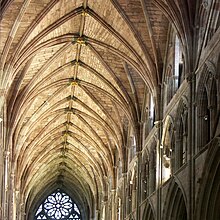
A pointed arch,
Early arches
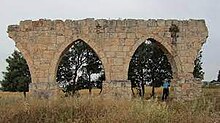
Crude arches pointed in shape have been discovered from the Bronze Age site of
The clearest surviving example of pre-islamic pointed archs are the two pointed archs of Chytroi-Constantia Aqueduct in Cyprus dating back to the 7th century CE.[6]
Pointed arches – Islamic architecture
The pointed arch became an early feature of architecture in the
-
Restored Abbasid architecture arches of the city gates of Samarra (9th century)
-
Central prayer niche in the Mosque of Ibn Tulun in Cairo (876–879 CE)
-
Bibi-Khanym Mosque, Samarkand, Uzbekistan (1399–1404)
-
TheEurymedon Bridge in Turkey, originally built by the Romans and rebuilt with a pointed arch in the 13th century by the Seljuk Turkish Sultan
-
Sheikh Lotfollah Mosque, Isfahan Iran (1603–1619)
The evolution of the pointed arch in Islamic architecture was associated with increases between the centers of the circles forming the two sides of the arch (making the arch less "blunt" and more "sharp"), from 1⁄10 of the
The appearance of the pointed arch in European
Gothic architecture – pointed arches and rib vaulting
The reduction of thrust on supports that a pointed arch provided, as compared to a semicircular one with the same load and span, was quickly recognized by medieval European builders. They achieved this at first through experimentation, but technical literature dating to the Renaissance indicates that formulas for determining thrust may have been in use during the medieval period.[15]
-
Thirteenth-century illustration by Villard de Honnecourt of how different pointed arches can be made from a single curve of the compass. From Eugène Viollet-le-Duc ""Dictionnaire raisonné de l’architecture française du XIe au XVIe siècle"'
-
Gothic pointed windows, colonnades and vaults at theAbbey of Saint-Denis, Paris, drawn by Eugène Viollet-le-Duc
-
The dynamics of a rib vault, with outward and downward pressure from ribs balanced by columns and buttresses. The pieces can stand by themselves, without cement. (National Museum of French Monuments, Paris)
-
An early sexpartite rib vault drawn by Eugène Viollet-le-Duc
-
Rib vaults of Durham Cathedral, with alternating columns and pillars, completed in 1135
-
Choir of Lessay Abbey in Normandy (1064–1178)
-
Vaulted ceiling of Cefalù Cathedral in Sicily (1131–1240)
-
Chapel of Saint Firmin in Basilica of Saint-Denis (1140–1144)
-
Lady Chapel of Salisbury Cathedral (1220–1258)
-
Choir of Beauvais Cathedral (begun 1225) (48.5 meters (159 ft) high
Rib vaults
In the 12th century, architects in England and France discovered a new use for the pointed arch. They began using the pointed arch to create the
The rib vault quickly replaced the
In the earliest type of Gothic rib vault, the sexpartite vault, the vault had a transversal pointed arch, and was divided by the ribs into six compartments. It could only cross a limited amount of space, and required a system of alternating columns and pillars. This type was used in Sens Cathedral and Notre-Dame de Paris. A new version was soon introduced, which reduced the number of compartments from six to four, distributed the weight equally to four pillars, eliminating the need for alternating columns and pillars, and allowed the vault to span a wider space. This quadripartite vault was used at Amiens Cathedral, Chartres Cathedral, and Reims Cathedral, and gave these structures unprecedented height. [18]
Portals
Portals of Cathedrals in the Gothic period were usually in the form of a pointed arch, surrounded by sculpture, often symbolizing the entrance to heaven.
-
Portal of Toledo Cathedral, the "Door of the Lions" (1226–1493)
-
West portal of Reims Cathedral (1211–1345)
-
Central portal of Chartres Cathedral (1194–1220)
Windows
The window in the form of a pointed arch is a common characteristic of the Gothic style. Windows sometimes were constructed in the classical form of a pointed arch, which is denominated an "equilateral arch", while others had more imaginative forms that combined various geometric forms (see #Forms). One common form was the lancet window, a tall and slender window with a pointed arch, which took its name from the lance. Lancet windows were often grouped into sets, with two, three or four adjacent windows.
-
Ruin of Aulne Abbey in Belgium (1214–1247)
-
Lancet windows
-
A Double-Lancet Window (about 1330) (Metropolitan Museum of Art)
-
Pointed windows of the nave of Sainte-Chapelle de Vincennes occupy near all the walls. (1379–1480)
The late Gothic, also known as the
-
Multiple arches of the Flamboyant Gothic at Sainte-Chapelle de Vincennes.
-
The Great Gate of Trinity College, Cambridge, an example of aTudor Arch or Four-centred arch
Forms

The most common form of the Gothic pointed arch in windows and arches was based upon an
In the later years of the
The
The Tudor arch, which is flatter than the Persian arch, was widely used in
Revival of pointed arch
Though the Gothic pointed arch was largely abandoned during the
-
Strawberry Hill House, residence of Horace Walpole (1749 onward)
-
Entrance to Victoria's Tower of theHouses of Parliament, London (1840–1876)
-
New Peterhof railway station, Peterhof, Russia (1857)
-
Interior of Grace Cathedral in San Francisco (1910–1964)
Notes and citations
- ^ Bechmann (2017), p. 322.
- ^ Woodman & Bloom 2003, Two-centred.
- ^ a b Mignon (2015), p. 10.
- ^ "The Project Gutenberg eBook of Mesopotamian Archæology, by Percy S. P. Handcock". www.gutenberg.org. Retrieved 2020-07-30.
- ^ Warren 1991, pp. 61–63
- ISSN 0066-622X.
- ISBN 9781351942584.
- ^ a b c Petersen (2002), pp. 25, 250–251.
- ISBN 9780195309911.
- ISBN 9780195309911.
- ^ Petersen (2002), pp. 283.
- ISBN 978-90-04-16339-3.
- ISBN 978-1-4744-6075-0.
- ISBN 978-1-351-69385-1.
- ^ a b c arco entry (in Italian) by C. Ewert in the Enciclopedia italiana, 1991
- ^ Woodman & Bloom 2003, Pointed.
- ^ Renault & Lazé (2005), p. 34-35.
- ^ Renault & Lazé (2005), p. 34–35.
- ^ Bechmann (2017), pp. 207–215.
- ^ Pugin, Augustus (1821). Specimens of Gothic Architecture: Selected from Various Ancient Edifices in England. Vol. 1–2. p. 3.
Bibliography
- Bechmann, Roland (2017). Les Racines des Cathédrales (in French). Payot. ISBN 978-2-228-90651-7.
- Bony, Jean (1983). French Gothic Architecture of the Twelfth and Thirteenth Centuries. ISBN 978-0-520-02831-9.
- Ducher, Robert (1988). Caractéristique des Styles (in French). Flammarion. ISBN 978-2-08-011539-3.
- Mignon, Olivier (2015). Architecture des Cathédrales Gothiques (in French). Éditions Ouest-France. ISBN 978-2-7373-6535-5.
- Petersen, Andrew (2002). Dictionary of Islamic Architecture. London: Routledge. ISBN 9780203203873.
- Renault, Christophe; Lazé, Christophe (2005). Mémento Gisserot de l'architecture. Mémento Gisserot : histoire de l'art (in French). OCLC 470449422.
- Warren, John (1991), "Creswell's Use of the Theory of Dating by the Acuteness of the Pointed Arches in Early Muslim Architecture", Muqarnas, vol. 8, Brill, pp. 59–65, JSTOR 1523154
- Woodman, Francis; Bloom, Jonathan M. (2003). "Arch". Oxford Art Online. Oxford University Press. ISBN 978-1-884446-05-4.
Further reading
- Viollet-Le-Duc, Eugene. Dictionnaire raisonné de l'architecture française du XIe au XVIe siècle (in French). (in nine volumes)


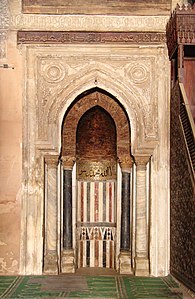
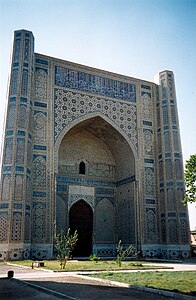
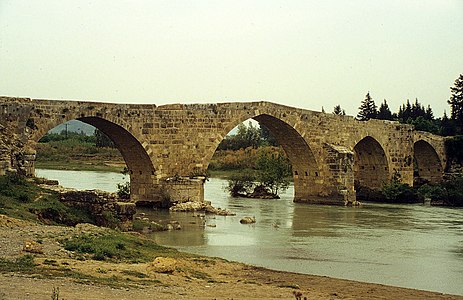
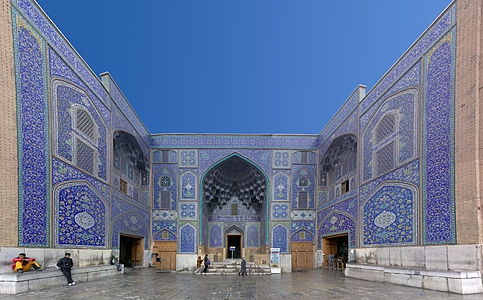
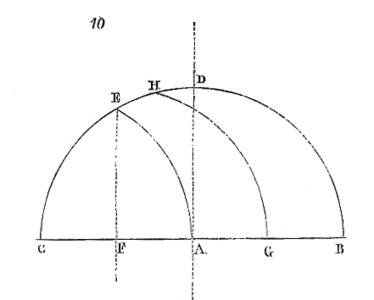



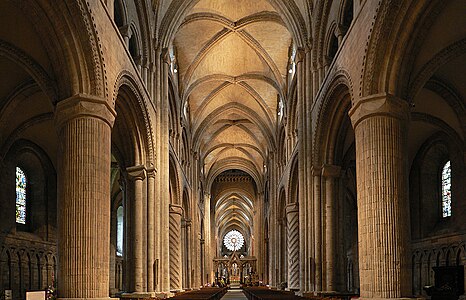








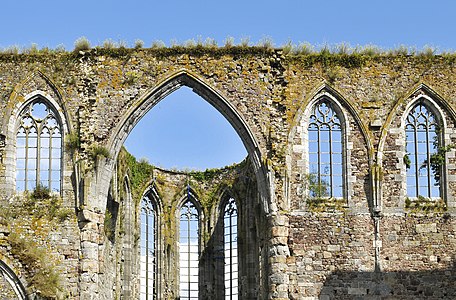
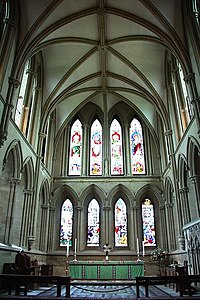
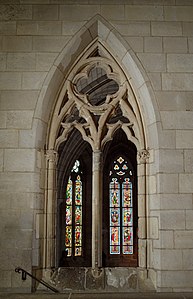
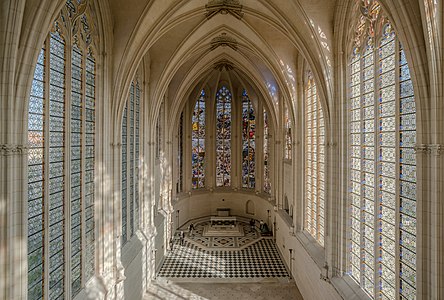


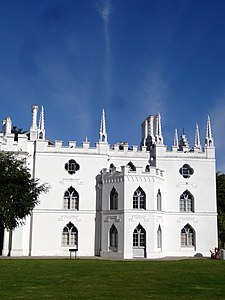

![New Peterhof railway station [ru], Peterhof, Russia (1857)](http://upload.wikimedia.org/wikipedia/commons/thumb/c/ca/%D0%A1%D1%82%D0%B0%D0%BD%D1%86%D0%B8%D1%8F_%D0%9D%D0%BE%D0%B2%D1%8B%D0%B9_%D0%9F%D0%B5%D1%82%D0%B5%D1%80%D0%B3%D0%BE%D1%84_-1.jpg/450px-%D0%A1%D1%82%D0%B0%D0%BD%D1%86%D0%B8%D1%8F_%D0%9D%D0%BE%D0%B2%D1%8B%D0%B9_%D0%9F%D0%B5%D1%82%D0%B5%D1%80%D0%B3%D0%BE%D1%84_-1.jpg)
